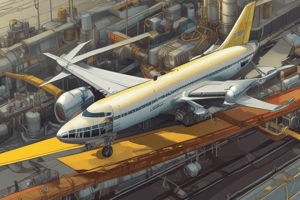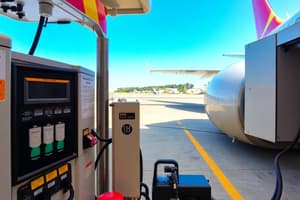Podcast
Questions and Answers
What is the maximum time that can be reduced from contingency fuel planning?
What is the maximum time that can be reduced from contingency fuel planning?
- 30 minutes
- 10 minutes (correct)
- 15 minutes
- 5 minutes
What is included in the supplementary fuel when planning for fuel insufficiency?
What is included in the supplementary fuel when planning for fuel insufficiency?
- Contingency and reserve fuel
- Contingency fuel only
- Trip fuel and alternate fuel (correct)
- Extra fuel only
What constitutes the minimum fuel for landing in cases of diversion to an ERA?
What constitutes the minimum fuel for landing in cases of diversion to an ERA?
- 30 minutes holding at 1500ft
- Just the final reserve
- 15 minutes holding at 1500ft (correct)
- Normal landing fuel requirements
What is the contingency fuel percentage that must be planned if PBC Contingency Fuel is unavailable?
What is the contingency fuel percentage that must be planned if PBC Contingency Fuel is unavailable?
In fuel planning for an alternate, what is the planned minimum distance for approach?
In fuel planning for an alternate, what is the planned minimum distance for approach?
What scenario allows for inflight fuel reduction under certain conditions?
What scenario allows for inflight fuel reduction under certain conditions?
What is the crew weight considered for fuel planning?
What is the crew weight considered for fuel planning?
What is the status of fuel when the aircraft is committed to land, possibly less than final reserve?
What is the status of fuel when the aircraft is committed to land, possibly less than final reserve?
What is the island reserve fuel calculated as?
What is the island reserve fuel calculated as?
What may the pilot in command (PIC) do regarding the prescribed minima?
What may the pilot in command (PIC) do regarding the prescribed minima?
What should be used in case of any discrepancy regarding altitude corrections?
What should be used in case of any discrepancy regarding altitude corrections?
Which action is required if the PA system is inoperative during an evacuation?
Which action is required if the PA system is inoperative during an evacuation?
What is the purpose of the Priority code in cabin interphone use?
What is the purpose of the Priority code in cabin interphone use?
What is the required information format for an emergency report?
What is the required information format for an emergency report?
How long does the PBE protect from smoke?
How long does the PBE protect from smoke?
What should the Commander do during the fuelling operation?
What should the Commander do during the fuelling operation?
What should be done if the seat belt sign is on during anticipated turbulence at 20,000 ft?
What should be done if the seat belt sign is on during anticipated turbulence at 20,000 ft?
Which item is NOT required to be secured during flight preparation?
Which item is NOT required to be secured during flight preparation?
What happens to an aircraft if dispensation is granted for a system required for EDTO?
What happens to an aircraft if dispensation is granted for a system required for EDTO?
Which visibility condition is necessary for LVO takeoff operations?
Which visibility condition is necessary for LVO takeoff operations?
Which statement is true regarding LVP before an LVO approach?
Which statement is true regarding LVP before an LVO approach?
What is required for the aircraft surfaces before take-off in cold conditions?
What is required for the aircraft surfaces before take-off in cold conditions?
What type of de-icing fluid is used to remove ice and has an ORANGE color?
What type of de-icing fluid is used to remove ice and has an ORANGE color?
If the leading edge of the wings is covered in ice, what action is taken?
If the leading edge of the wings is covered in ice, what action is taken?
What is the visibility requirement for conducting an instrument approach and landing?
What is the visibility requirement for conducting an instrument approach and landing?
What happens if the requirement for anti-icing is met after de-icing?
What happens if the requirement for anti-icing is met after de-icing?
What does an Amber warning during a bomb threat indicate?
What does an Amber warning during a bomb threat indicate?
Which level of unruly passenger behavior is classified as physically abusive?
Which level of unruly passenger behavior is classified as physically abusive?
What is the maximum allowable speed deviation from ATC instructions during departure and arrival?
What is the maximum allowable speed deviation from ATC instructions during departure and arrival?
What should the PM do if unable to maintain the speed specified by ATC?
What should the PM do if unable to maintain the speed specified by ATC?
What is the maximum speed to maintain below 5000 FT AAL?
What is the maximum speed to maintain below 5000 FT AAL?
Which condition allows the crew discretion to board passengers despite hot cabin temperatures?
Which condition allows the crew discretion to board passengers despite hot cabin temperatures?
Under what condition can ground crew start the APU in relation to hot cabin policy?
Under what condition can ground crew start the APU in relation to hot cabin policy?
What airspeed adjustments occur when using the FCTM-Holding technique?
What airspeed adjustments occur when using the FCTM-Holding technique?
What should be avoided regarding the use of engine bleed supply and air start unit?
What should be avoided regarding the use of engine bleed supply and air start unit?
Which of the following statements about ATC communication is true when maintaining runway heading?
Which of the following statements about ATC communication is true when maintaining runway heading?
What is the maximum brake temperature limit for takeoff to ensure safety from potential ignitions?
What is the maximum brake temperature limit for takeoff to ensure safety from potential ignitions?
What should be done if an aircraft needs to occupy the active runway for more than 90 seconds after line-up?
What should be done if an aircraft needs to occupy the active runway for more than 90 seconds after line-up?
During a derated climb, what happens if an engine-out (EO) situation occurs?
During a derated climb, what happens if an engine-out (EO) situation occurs?
What does a Cost Index (CI) of 0 signify for flight operations?
What does a Cost Index (CI) of 0 signify for flight operations?
What condition requires the crew to update wind and temperature data?
What condition requires the crew to update wind and temperature data?
Which speed represents the maximum permissible speed below 5,000 FT AAL?
Which speed represents the maximum permissible speed below 5,000 FT AAL?
When the crew uses selected speed/Mach, what does the FMS assume?
When the crew uses selected speed/Mach, what does the FMS assume?
What does the calculation of ETP depend on?
What does the calculation of ETP depend on?
What procedure should be followed for a cabin ready notification during takeoff?
What procedure should be followed for a cabin ready notification during takeoff?
What does an upgrade of runway condition code (RWYCC) to 3 indicate?
What does an upgrade of runway condition code (RWYCC) to 3 indicate?
Flashcards are hidden until you start studying
Study Notes
Fuel Policy
- Taxi fuel considerations include APU use, engine starts, and taxiing for departure.
- Trip fuel stages involve takeoff, SID, cruising FPR, descent via STAR, and approach/landing, all factoring in planned landing weight, SID & STAR expectations.
- Contingency fuel accounts for extended taxi, delays, altitude restrictions, route changes, and forecast errors; minimum contingency is 5% of trip fuel if PBC contingency is unavailable.
- Additional fuel may be necessary if total trip, contingency, alternate, and reserve fuel is insufficient for holding or expected diversion.
- Alternate fuel policies include considerations for minimum approach and climb to cruising altitude with 5% contingency.
- Final reserve rules dictate minimum fuel for safe landing, with provisions for holding at alternate destinations and adjustments for emergencies.
Inflight Fuel Reduction
- In-flight fuel management allows less than MDF under specific conditions such as runway independence, favorable weather, and clear paths to destination.
- Minimum fuel indicates a commitment to land, while mayday fuel indicates fuel below reserve levels.
Planning Minima
- Operational information from CPA has overriding authority; PIC can impose higher minima.
- Flights must include instrument approach aids; corrections are made for temperature at specific altitudes.
SEPM - Emergency Protocols
- Priority code enables urgent communications to the flight deck; varies by aircraft type (A330, A320/A321, A350).
- Emergency reports follow the format of "WHO WHAT WHERE."
- Alert phase initiated by ISM attention calls and cancellation indicates return to normal operations.
- Brace or evacuation commands may use visual signals if PA is inoperative.
Safety Equipment Checklist
- Regular checks confirm status of ELT, torches, life jackets, fire extinguishers, and personal breathing equipment (PBE).
Bomb Threat Procedures
- Positive identification of a threat requires varying protocols for crew and passenger disembarkation.
Unruly Passengers
- Behavior escalates through levels from disruptive to life-threatening; interventions escalate from warnings to restraint.
Operational Procedures
- Early preparation for APU INOP MEL includes requesting an air start unit.
- Cabin temperature management during boarding may grant PIC discretion in passenger loading based on conditions.
Speed Control and ATC Compliance
- Speed deviations include specific considerations for both departure and cruising conditions; operational issues communicated immediately.
- LVPs must be observed for low visibility takeoffs and landings, including specific visibility measures for ILS approaches.
De-icing and Anti-icing Policies
- Guidelines for acceptable frost levels on wings; specific de-icing types (Type 1, 2, and 4) serve different purposes during winter operations.
- Anti-icing procedures follow depending on contaminant conditions after de-icing is completed.
Departure Procedures
- The TCRAP (Time, Chart, Clearance, Radnav, Altitude, Performance) method guides final checks before takeoff.
- Takeoff thrust adjustments based on wind conditions to ensure aircraft control and safety.
Management of Emergency Situations
- EO procedures activate derated climb thrust changes, continuously optimizing fuel usage and altitude adjustments.
- Speed maintenance is crucial; specific thresholds determine managed speed and adjustments in flight.
Approach and Descent Management
- Monitor weather and altitude shifts to optimize aerodynamics and operational safety.
- Fuel plans during cruise include allowances for diversion contingencies and holding times.
Dispatch Considerations
- Review status pages and deferred procedures before takeoff; pay attention to runway conditions and relevant NOTAMs affecting operations.
Studying That Suits You
Use AI to generate personalized quizzes and flashcards to suit your learning preferences.




